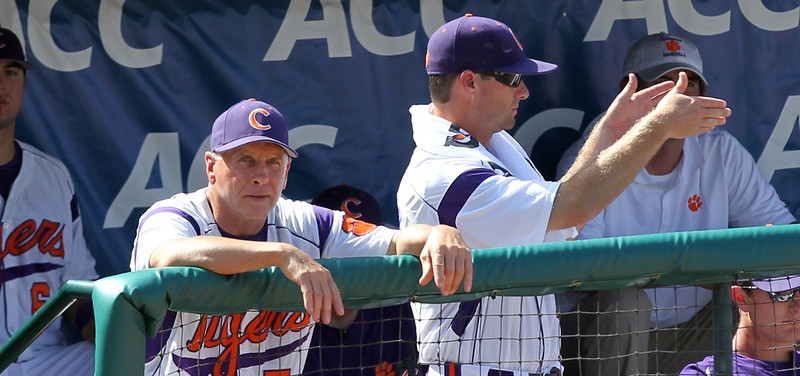
ACM, Clemson have long way to go
In 2011, Clemson head baseball coach Jack Leggett began pushing Clemson University to use the Academic Common Market as a way to help student-athletes, not from the state of South Carolina and not on full scholarship, pay their tuition.
Baseball scholarships are not like football or basketball scholarships, the NCAA only allows Division I baseball programs to have 11.7 scholarships to distribute to 27 players. The kicker, players must be given at least 25 percent scholarship money.
At Clemson, that means the majority of the roster has to find some other means of paying its way through school. For some, their parents take care of it, while others qualify for other grants-and-aid. But some, especially those from other states, end up having to take out student loans. Keep in mind 17 players on Clemson’s 2015 roster are from out of state—mostly from Georgia. This is where the Academic Common Market (ACM) can help.
The ACM has been in place for 35 years and is a tuition-savings program for college students in the 16 Southern Regional Education Board states who want to pursue degrees that are not offered by their in-state institutions. Students can enroll in out-of-state institutions that offer their degree program and pay the institution’s in-state tuition rates.
In other words, with Clemson offering sports communication as a major and a player wants to pursue that as his chosen field and it isn’t offered in a state like Georgia, which participates in the ACM, then he will be eligible for the ACM and will only have to pay for in-state tuition at Clemson.
Bradley LeCroy, who used the ACM when he was the recruiting coordinator at Tennessee, and Leggett addressed this issue with then athletic director Terry Don Phillips in 2011. Phillips then presented the case to former Clemson University President James Barker. But the Barker administration was not a fan of the ACM and worried it could hurt Clemson’s pursuit to be a top 25 academic institution.
When Dan Radakovich took over as athletic director and Jim Clements as university President, LeCroy and Leggett approached the new administration about the ACM and this time it got passed. The Clemson Board of Trustees passed the ACM last April and potentially four baseball players, as part of the 2015 Class that will enroll later this summer, are expected to get aid to help with high cost of out-of-state tuition.
“It helps some,” a source close to the baseball program told The Clemson Insider, “but it’s not as good as other schools. The Clemson program just started it and other schools have had the program in other states for a long time.”
Clemson accepts just 35 ACM students each fall and once the slots have been filled, they do not accept additional students through the programs. Student athletes must be approved for the ACM by their first semester at Clemson and they must be a first-time freshmen or first-time graduate student.
In other words, members currently on the 2015 Clemson roster will not be eligible for the ACM.
“It’s a step in the right direction, but they still have a long way to go,” the source said.
Clemson has 14 majors that are inside the academic common market, and all subsequent offerings are coming forward based on request and need.
“If we want to put accounting, for example, on the academic common market we would have to go to the state of Georgia and Georgia would have to look through all of their schools and say there is no accounting degree so we will do the reciprocity and give them in-state tuition at Clemson,” Radakovich said.
“Parks & Recreation and Tourism, various horticulture majors, Pan-African studies, sports communications, those are all things that are unique for example. Georgia or Virginia or other states, they don’t have them therefore (the major) will link into the common market.”
The key for Clemson is to make sure the ACM is something student athletes would be interested in. Why? Receipt of an ACM waiver may affect eligibility for other recruiting scholarships.
“We rely on our coaches to come back to us and say, ‘I was recruiting Susie of Johnny and they wanted to see if we can place (horticulture) on the academic common market?’ There is a process to go through in order to do that and there is really no inhibiting us to put another major through to run that process and run the gamut of the different states,” Radakovich said. “There is no guarantee that it comes back that way with a positive answer.
“The folks on campus have told us ‘As you find some of these, let us know and we will see if we can do it.’”
With Clemson unable to guarantee a prospect it can get him at least eligible for the ACM, other schools like Virginia, North Carolina and Vanderbilt have found other means that can entice a potential baseball recruit away from Clemson.
For example, North Carolina has a program that is 100 percent need base, meaning a prospects’ parents can only pay $10,000 a year, then the school—thanks to its $2.6 billion endowment—will take care of the rest.
There are a lot of situations like North Carolina’s that Clemson competes against on the recruiting trail. Even South Carolina, who competes with Clemson for a lot of the same talent from the state of Georgia, has more academic money and financial aid to offer.
“It doesn’t come close to the other financial aid that other schools get to work with,” the source said.
Of course none of this was a factor at Clemson until the NCAA forced baseball coaches in 2010 to give just 27 student-athletes the 11.7 scholarships at least 25 percent.
Also something Clemson’s Olympic sports have to consider when recruiting a student athlete who may want to use the ACM, they have to make sure all the space isn’t taken up. Any incoming freshmen planning to attend Clemson this fall and beyond, is eligible for the 35 slots.
So what happens if all 35 slots are taken?
“We don’t have that conversation until we reach thirty,” Radakovich joked. “I’m just being realistic. It is kind of moving forward as it moves forward and if it gets to a point where we are approaching that ceiling then we will need to talk about, A) has this program been good for Clemson as a university. And if we can say, ‘Hey, it has been really good for athletics so that’s a thumbs up from us,’ has there been some other positives?
“Then the university has to go out and make a decision, but that is not on our critical path right now. We are still beginning to use it.”
And for Clemson’s Olympic sports, especially the baseball program, they hope it gets better sooner rather than later.
In 2011, Clemson head baseball coach Jack Leggett began pushing Clemson University to use the Academic Common Market as a way to help student-athletes, not from the state of South Carolina and not on full scholarship, pay their tuition. Baseball scholarships are not like football or basketball scholarships, the NCAA only allows Division I baseball programs to have 11.7 scholarships to distribute to 27 players. The kicker, players must be given at least 25 percent scholarship money. At Clemson, that means the majority of the roster has to find some other means of paying its way through school. For some, their parents take care of it, while others qualify for other grants-and-aid. But some, especially those from other states, end up having to take out student loans. Keep in mind 17 players on Clemson’s 2015 roster are from out of state—mostly from Georgia. This is where the Academic Common Market (ACM) can help. The ACM has been in place for 35 years and is a tuition-savings program for college students in the 16 Southern Regional Education Board states who want to pursue degrees that are not offered by their in-state institutions. Students can enroll in out-of-state institutions that offer their degree program and pay the institution’s in-state tuition rates. In other words, with Clemson offering sports communication as a major and a player wants to pursue that as his chosen field and it isn’t offered in a state like Georgia, which participates in the ACM, then he will be eligible for the ACM and will only have to pay for in-state tuition at Clemson. Bradley LeCroy, who used the ACM when he was the recruiting coordinator at Tennessee, and Leggett addressed this issue with then athletic director Terry Don Phillips in 2011. Phillips then presented the case to former Clemson University President James Barker. But the Barker administration was not a fan of the ACM and worried it could hurt Clemson’s pursuit to be a top 25 academic institution. When Dan Radakovich took over as athletic director and Jim Clements as university President, LeCroy and Leggett approached the new administration about the ACM and this time it got passed. The Clemson Board of Trustees passed the ACM last April and potentially four baseball players, as part of the 2015 Class that will enroll later this summer, are expected to get aid to help with high cost of out-of-state tuition. “It helps some,” a source close to the baseball program told The Clemson Insider, “but it’s not as good as other schools. The Clemson program just started it and other schools have had the program in other states for a long time.” Clemson accepts just 35 ACM students each fall and once the slots have been filled, they do not accept additional students through the programs. Student athletes must be approved for the ACM by their first semester at Clemson and they must be a first-time freshmen or first-time graduate student. In other words, members currently on the 2015 Clemson roster will not be…
Click below for the full article
ACM, Clemson have long way to go
Source: The Clemson Insider



Facebook
Twitter
Pinterest
Instagram
YouTube
RSS